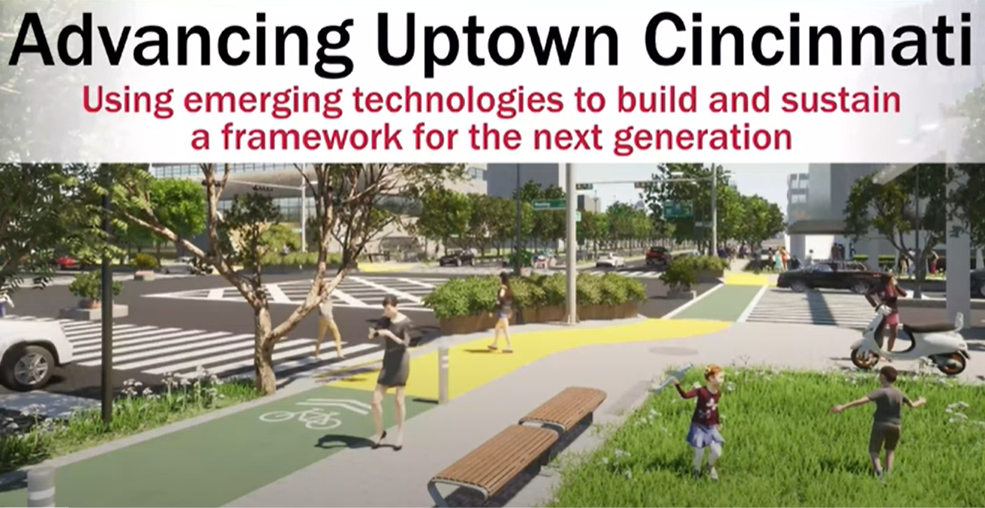On May 17, Uptown Consortium, Inc. (UCI) gathered various stakeholders to help envision ways to improve mobility, transportation connectivity and access in and around the MLK and Reading Road intersection. The visionary and stimulating session included Uptown residents and employers, project developers, team members of Cincinnati City Council, representatives of The Ohio-Kentucky-Indiana-Regional Council of Governments (OKI) and transportation experts, among others.
To give you a sense of just how dynamic and productive the workshop was, here’s a video recap prepared by University of Cincinnati (UC) student, Logan Stryker:
This workshop, which was held at the Digital Futures building, the centerpiece of the Digital Futures Complex in the Cincinnati Innovation District, was the third phase of a journey that began last year. It followed discussions and a walkabout of the area, and a design charrette to discuss and map solutions at this critical intersection and the surrounding subarea.
A highlight of the workshop was an interactive experience developed by the students of The UC Future Mobility Design (FMD) Lab under the leadership of its director, Alejandro Lozano Robledo. The FMD Lab team took ideas and concepts from the previous design charette and created a virtual reality (VR) experience showcasing future technology and mobility integration of what MLK and Reading Road could look like in 10 years, which can be seen below.
“VR has the power to open people’s minds by making the future more real and tangible,” said Lozano Robledo. “The workshop participants were clearly energized by the opportunity to interact with some of the solutions that they helped develop.”
In addition, the FMD Lab team shared background on trends reshaping the future of mobility and cities, such as: by 2040, more than half of the vehicles on the road will be autonomous, and smart cities will enable safer and more people-centric streets. The VR experience and the trends report accelerated further discussion and ideation around three mobility focus areas, connectivity and access themes: cars and bikes; pedestrians and bikes; and infrastructure and environment.
With an eye towards ‘what’s next & now’, workshop participants were prompted to look at two-to-five-year solutions that UCI’s transportation consultant, Rick Record of RL Record LLC, compiled from the previous design charette. The Lab created images of the focus areas so the group could workshop solutions.
“It’s terrific that UCI is taking mobility and related issues seriously and engaging stakeholders in various ways to envision the best future for Uptown,” Record said. “Actively planning for immediate, needed changes to address mobility, quality of life, safety and environment will position Uptown for the best future outcomes knowing that conditions will continue to change. These efforts will benefit countless people moving around and through Uptown.”
Here are some of the recommendations that have emerged from the three phases:
Reducing number of turn lanes, replacement with planted median or curb extensions, and reducing overall intersection footprint;
Establish uniform travel lane widths of not more than 11 feet, possibly narrower, on all approaches, all lanes;
Various forms of enhanced transit will be accommodated, including more frequent service, linkage to a nearby transit center, and future bus rapid transit in adjacent parts of the network;
Rework of curbs and footprint, crosswalk width and location (10’ minimum width); contrast zebra markings; high intensity pendant LED lighting above centerline of each pedestrian crosswalk (with lighting actuated by “walk” request or cycle control, day/night);
Integrated, green/ yellow marked bike crossing (5’ width minimum) on outboard edge of each pedestrian crossing; coordinated curb area markings, with orientation and physical indications to buffer and control ped versus bike each corner; traffic stop bar to cl ear /protect ped + bike;
Increase integrated (Ped + Bike) walk width to 10’ min all 4 approaches to intersection; consider +5’ green bikeway on NE and SE quad approaches; ‘street life’ accommodation;
Possible new robot delivery traffic on sidewalks, future micromobility lanes, and automated shuttles in curb lanes sharing bus stops for transfer;
New mast/arm type signal, signage and lighting, replacing existing pole / cable system; additional masts to carry pendant LED lighting on crosswalk axes; general area lighting options beyond crosswalks;
Signal progression pre-emption for clearing queues under approach of EMS vehicles (GPS control and actuation); and
Proposing interventions and understanding implications of all situations including nighttime, rain, and snow.
“Vital to any community’s success is the ability for people to move around and through it, whether on foot, on a bike or scooter, on public transportation or in a private vehicle,” said Record. “Mobility impacts resident and visitor satisfaction and businesses' ability to attract and retain employees and customers. This is why we applaud UCI for proactively bringing together stakeholders to tackle this important issue.”
“It was important for us to create a forum and process for Uptown stakeholders to voice their concerns and share their ideas for improving mobility in and around the MLK/Reading Road intersection,” said Beth Robinson, UCI’s President and CEO. “This process has led to smart, clever solutions that will help prepare that area for the future.”
Robinson said that the search for the best mobility solutions is still ongoing. “The three phases of engagement provided a robust amount of stakeholder feedback that will help UCI secure funding to bring these ideas to life to advance Uptown’s transportation network.”
Uptown stakeholders aren’t just waiting on the future, they’re helping to shape it.












